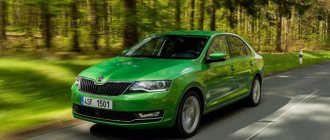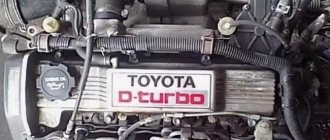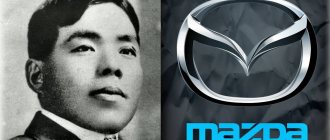Add a comment
14 min. reading
Updated: 01/14/2021
Toyota Motor Corporation (“Toyota Motor”) is a Japanese corporation engaged in the design, production and sale of automobiles and automobile spare parts.
The Japanese automaker likes to position itself beautifully – “Today. Tommorow. Toyota" (Today. Tomorrow. Toyota) - this is one of its slogans. Is there any reason for such pride?
In 2021, this brand took 1st place among automakers in the “BrandZ Top 100” ranking. Toyota Motor is one of the largest automobile companies in the world and also produces cars under the brands Hino, Daihatsu, and Lexus.
Until 2021, the company was the leader among auto giants in terms of market value, but had to give up 1st place to Tesla. In 2020, the capitalization of Toyota Motor Corp. according to Forbes amounted to $173.3 billion. In the ranking of the Most Valuable Brands 2020 of this financial publication, the corporation ranks 11th with a sales volume of $187 billion. In the list of the world's largest public companies Global-2000 in 2020, Toyota Motor is in 11th place with sales of $280.5 billion, profit of $22.7 billion, and assets of $495.1 billion.
The company employs about 360 thousand workers, and up to 9 million cars roll off the production lines every year! The production rate of Toyota models is easy to calculate - 1 car every 6 seconds!
Since 1982, Toyota has been a member of the “Big Three” - the informal title of the three largest automobile manufacturers does not remain constant - and if at first the leadership of American manufacturers was unconditional (the Detroit Three included General Motors (GM), Chrysler and Ford), now it is obvious the new triarchy is still the same GM, but already Toyota and Honda, with Volkswagen and Hyundai stepping on their heels.
It seems that there really is reason to be proud. But how did the corporation achieve such impressive results? After all, the Japanese company is interesting not only for its financial performance, but also for its special business model. How did the history of the Toyota Motor brand develop?
Where it all began
The company was founded by Kiichiro Toyoda, whose biography is discussed in a separate article.
Founder of Toyota Motor
The history of the Japanese company began back in 1933 in the Japanese city of Toyota, where 7 of its 12 factories are now concentrated and the head office is located. But it was not the city that gave the name to the famous company. Everything turned out just the opposite: the city, until 1959 indicated on maps as Koromo, acquired a new name in honor of the leader of the automobile industry, which to this day determines its economy.
The car company has textile roots. In 1933, Toyoda opened an automobile division based on Toyoda Automatic Loom, his father's Works company, specializing in the textile industry. The day of establishment of the Department of Automobile Industry becomes the “Day of Knowledge” 09/01/1933. It was weaving machines that helped obtain initial capital for the development of the automotive industry - Toyoda Sr. profitably sold a patent for the development of an automatic spinning machine. It is believed that these proceeds, which amounted to £100,000 according to the agreement, launched the automotive division. In the biography of Kiichiro Toyota, the question is “one hundred thousand” - where did the money go? – considered in more detail.
The history of the company's auto production began with the active support of the state, which was not satisfied with the dominance of American auto giants (Ford Motor, GM, Chrysler) in the local market. Kiichiro began buying, disassembling and “creatively recycling” cars made in the USA and Europe.
History of the company name and logo
Toyota Motor received its name from its founder, Mr. Kiichiro Toyoda, who slightly transformed his surname by replacing the “d” with a “t” - the changed name was written in eight characters, and “8” is considered a lucky number in Japan.
They believe correctly in Japan - those who are patient will not succumb to poverty. To this day, some people see the Toyota Motor logo as a twisted thread with a needle, in memory of the textile roots of the automobile company. However, according to the official version, the logo reflects the balance between the corporation, customers and competitors.
Company brand image
The Toyota Motor brand was the most expensive among automakers until 2021. In the Interbrand ranking of the most valuable brands in the world in 2021, the Japanese brand is valued at $56.2 billion and occupies 7th place. Among the main factors for the effectiveness of a Japanese brand, Interbrand lists relevance, authenticity and market presence.
Pre-war and post-war period in the history of the company
Copying and searching for optimal design solutions - this was the initial stage of the future leader of the automotive industry. Having disassembled and studied American cars Chevrolet (General Motors) and Chrysler Airflow, in May 1935 the automobile division produced its first own car, Model A1. In the same year, in November, the G1 model truck appeared, the prototype of which was Ford.
After the presentation of manufactured vehicles in 1936, the state issues a promising company a license to produce cars and trucks. On August 28, 1937, the automotive department of textile production became an independent company - Toyota Motor Co., Ltd. In the same year, the company received a large government order for 3 thousand trucks worth 100 thousand pounds sterling.
In 1938, the company began mass production of a new car model - Model AA.
Toyota Model AA
The Toyoda Science Research Center has been operating since 1939. The founder of the company understood the importance of his own innovative developments, because simply copying “you won’t get far.”
The years of World War II were the heyday of the company, which received good income from military orders. Production was put on a “military footing”: the company produced KB model trucks, Su-Ki amphibious vehicles, and AK10 series SUVs. Toyoda creates subsidiaries for the production of steel, metalworking machines, and components. Independence from suppliers is becoming a serious advantage for Toyota Motor.
After the end of the war, due to occupation and inflation, the company found itself on the verge of bankruptcy. Kiichiro introduces austerity policies that lay the foundation for the basic principle.
In the post-war period, the company produced trucks for the occupation government and repaired cars.
In 1947, production of the Toyota Model SA mini-car began. The budget car, accelerating up to 54 km/h, had a prototype based on the Volkswagen Type 1
Due to its compact dimensions, the SA series car was dubbed the “Baby Toyota” (Toyopet), model produced in 1947
Gradually, Toyota Motor increased production, which was prompted by the lifting of the ban on the production of personal cars and bank loans in 1949. In 1950, the company produced more than 11 thousand cars, 5 years later - twice as many.
In 1955, the first full-fledged Toypet Crown car was launched. The same year brought the company the title of “the largest Japanese automaker.”
Company team
In 1949, due to layoffs and wage reductions, a workers' strike occurred at the plant. To avoid an escalation of the conflict, Toyoda resigned as president in 1950. As a result, in order to prevent the ruin of the company, it was still necessary to carry out unpopular mass layoffs: out of 8 thousand workers, 6.4 thousand were left. Toyoda did not plan to leave the company for a long time, but life decided differently - in 1952 he died.
The founder always valued the contribution of the team; back in 1935, Kiichiro Toyoda formulated 5 principles, one of which read: “Always strive to create a homely, warm and friendly atmosphere at work.”
The company's current leadership, led by Chairman Takeshi Uchiyamada and President Akio Toyoda, continues to embody the principles of the company's founder.
In 2014, a motivational project for employees “The road “builds” people, and people build cars” was launched. The core idea of the initiative is to train employees to experience driving on all types of roads around the world, ultimately gaining a deeper understanding to build the cars of the future.
Toyota hydrogen fuel cell concept car at the Megaweb Toyota City Showcase in Tokyo
According to Bloomberg, 369,701 people work under the wing of the auto giant; according to Forbes, the company employs 370,870 workers; the corporation itself indicates a smaller number of 359,542 thousand, including more than 70 thousand workers in Japan itself. Enterprises abroad usually hire local personnel.
Production in St. Petersburg
Cooperation between Japan and Russia to establish the production of Toyota Corolla began with the construction of a plant in 2005. The Leningrad region was chosen as the location for the construction of the car assembly plant. This place was Shushary, where the first Toyota Corolla was assembled in 2007.
The company employs about 2 thousand people. Workers undergo training and internships at automobile production facilities in Japan. The workshops carry out welding, painting of Corolla bodies, and also assemble them until they are fully operational. Product quality requirements are similar to those of factories in Japan. In 2013 alone, more than 35,000 vehicles left the company's gates.
The beginning of a successful phase in the history of Toyota Motor
The sales division is separated into a separate company, which leads to an increase in export sales; The auto repair and maintenance department also becomes an independent company. The company begins a successful period.
In the 50s Land Cruiser appears.
In 1961, the Toyota Publica model was released - a budget car that quickly gained fame. In 1962, the company celebrated the production of its millionth car, ten years later - the 10 millionth.
1961 Toyota Publica
In 1966, the top-end model of Toyota Motor appeared - the Corolla car, which deserved the title of mass production. Since 1966, cars of this brand of various modifications have sold over 40 million units! The Toyota Corolla C class became a bestseller and is included in the Guinness Book of Records as the best-selling car in the world.
1966 Toyota Corolla
Meanwhile, Toyota Motor enters into a business agreement with Japanese firms Hino and Daihatsu, which become its subsidiaries.
In the 70s the company is working at full capacity - new factories are opening, equipment is being modernized, the Celica, Sprinter, Tercel, etc. models are being produced. In the early 80s, production of the Camry model began, in 1986 the 50 millionth car was produced.
1985 Toyota Camry
In 1982, divisions of Toyota Motor Co., Ltd. and Toyota Motor Sales Co., Ltd. merged into one corporation, Toyota Motor Corporation.
In 1988, Toyota introduced a new brand of luxury cars - Lexus, which changed the image of the company as a manufacturer of exclusively budget cars. The Lexus model firmly occupies the niche of premium class cars. It becomes a symbol of luxury, known even to a child: “On the program “The Smartest,” fifth-grader Vovochka won, who, when asked “carrots, onions, potatoes, Lexus - what’s extra?” The correct answer was “carrots, onions, potatoes.”
Lexus
In 1988, the company completed the construction of its own test site in Shibetsu and, as part of its research activities, opened joint projects with companies such as Fujitsu, IBM Japan, and Toshiba.
In 1997, the “hybrid car” was released - a mixture of a conventional car with an internal combustion engine and an electric car, which is powered by an electric charge. Thus, a hybrid car takes all the best from a gasoline engine and an electric motor. The Toyota Prius hybrid car model, created in 1997, sold 20,000 copies in its first year of sales.
Toyota Prius hybrid car
Another model of the Toyota Auris Hybrid hybrid car was included in the Guinness Book of Records for record efficiency in its class - the fuel consumption of this model is 3.46 liters per 100 km in the city.
In the same year, Toyota Motor released the first generation of electric vehicles - the RAV4 EV was released - an electronic version of the RAV4 crossover.
In 1999, the 100 millionth Toyota car rolled off the assembly line.
What Toyota models are assembled in Russia
Some models of this company are assembled on the territory of the Russian Federation in St. Petersburg. In 2005, construction of a TOYOTA plant began on the territory of the village of Shushary on an area of 224 hectares in St. Petersburg, and 2 years later the first Russian-assembled Toyota rolled off the assembly line. The plant's capacity makes it possible to produce body parts from metal and plastic, assemble, weld and paint cars.
The plant provides a free recycling service for end-of-life Camrys and RAV4s produced at the plant. In order to dispose of a car, you will need to deregister the car, deliver it to the territory of the recycling company and receive a disposal certificate.
Important! The company does not provide compensation for disposal!
The list of models produced at this plant cannot boast of its volume and consists of only two cars: Camry and RAV4.
In 2007, the first Camry rolled off the assembly line. By 2015, we managed to reach the mark of 100 thousand cars per year. It is worth noting that this Toyota model is assembled only at a Russian plant.
In 2021, the capacity of the Russian plant made it possible to organize an assembly line for the RAV4 model.
From 2013 to 2015, Land Cruiser Prado , but for unknown reasons, production returned to Japan.
Toyota in Russia
In the 90s begins the history of Toyota Motor's promotion in the Russian market, which is one of the highest priorities for the company. In 2007, a car assembly plant began operating in St. Petersburg (the village of Shushary), and the first Toyota Camry rolled off the assembly line in December. The St. Petersburg plant, which occupies 224 hectares, employs about 600 employees. The company produces the best-selling models of the Japanese auto giant – the Camry and RAV4 models.
In 2021, Toyota Motor entered the TOP 20 “Favorite Brands of Russians” (19th place).
Production of Toyota Camry at the St. Petersburg plant
In 2005, Toyota entered into an agreement with the Russian government to build an automobile plant in St. Petersburg, more precisely in its industrial zone. Production began in 2007. The product produced was a Toyota Camry. The production volume began with 20 thousand cars, and in the future it was planned to increase this figure to 300 thousand cars per year. The produced cars were intended for the Russian market.
But this never happened and production began to decline over time.
Thus, in the first half of 2014, only a little more than 13 thousand cars were produced. During the same period in 2013, 1.5% more cars were produced. Where are they, these 300 thousand cars that the manufacturers were counting on? Toyota Camry cars, in order to maintain sales volume, began to be supplied to Kazakhstan and Belarus. At the very beginning, more than $150 million was invested in this project.
More on the topic:
- New crossover Changan CS95 enters the market
Most recently, Toyota has completed the creation of new stamping workshops. It is also expected that in a few years the assembly of the Rav 4 crossover will begin at the St. Petersburg plant. True, there is reason to doubt the effectiveness of this company, whether everything will turn out the same as with the Toyota Camry. Many did not like the quality of assembly carried out in Russia.
2000s
In 2007, the company proudly announced that its sales volumes exceeded those of its main competitor, General Motors. In 2012, the corporation's 200 millionth vehicle rolled off the assembly line.
In 2011, the strongest earthquake in the entire known history of Japan leads to the forced shutdown of the company's factories. But already in 2012, Toyota Motor restored production and introduced a number of new models to the market.
Since the end of 2021, the company has been paying increased attention to electric cars, and iQ EV was also released.
But the company’s eyes are not only focused on earthly roads; as it turns out, not only Elon Musk, Jeff Bezos and Richard Branson dream of space. In 2021, Toyota Vice President Shigeki Terashi presented the planetary rover project jointly with JAXA and emphasized that “since our founding, we have adhered to the philosophy that we should do everything possible to benefit society... I am honored to participate in the project , aimed at expanding the scope of human activity to the Moon."
According to the project, the rover is capable of accommodating 2 crew members / photo from the company’s website
In 2021, a new research center opened in Aichi Prefecture. The scientific complex is partially operated and will operate at full capacity by 2023. The automobile concern invested more than $2.8 billion in the construction of the center, located on 650 hectares and including testing grounds for high-speed and off-road testing.
Opening of the research center, 2019
Plant in Takaoka
This is the original and most powerful plant of the Japanese automobile brand in the world. The company began operating in 1918. Initially, weaving machines were produced here. But, over time, they began to collect vehicles. Six million cars roll off the assembly line every year.
The company assembles as many as ten models of the brand, including:
- Toyota Corolla;
- Toyota Prius;
- Toyota Camry;
- Toyota RAV4;
- Toyota Highlander;
- Toyota Auris;
- Toyota FJ Cruiser.
Takaoka has 280 thousand employees. In addition to passenger cars, components for vehicles, equipment, trucks and buses are produced here. We hope you will no longer have the question: where are Toyotas produced in Russia, and what models are produced here? The rapid growth of this Japanese enterprise began in the fifties, when the Japanese began to open factories in other countries (Thailand, Brazil, America).
Cars produced by the plant in Takaoka are low cost and economical in terms of fuel consumption. About ten thousand cars roll off the assembly line every month. In addition, trailers and semi-trailers for special equipment are produced here. The developer is trying to develop and improve its factories, opening new workshops with the latest modern equipment.
Company production system
A major role in the company's success was played by its production system, the Toyota production system (TPS), which represents a set of production principles. The main creator of TPS is considered to be Tahiti Ono, who worked at the Toyota Motor plant since 1943.
The “kamban” principle, which is one of the main ones in TPS, strives everywhere and always to eliminate the loss of time, materials and production capacity. The principle of “kamban” is the refusal to produce large batches of products, when the parts needed for the conveyor line appear on it at the required time and in the required quantity. This allows you to free up production space and eliminate some of the storage space. Therefore, “kamban” requires planning and implementing production orders not by months and weeks, but by days and hours!
The “just in time” principle, also known as “just in time”, works everywhere – both at the stage of ordering raw materials and components, and at the stage of shipping finished products.
Surprisingly, even now the stock of parts at the company’s production is only 1.5 hours, and on the production line it can even be half an hour.
Tahiti Ohno also formulated the principle of “genchi genbutsu”, the meaning of which is the need to see the center of the problem with one’s own eyes. If any complications arose, Taichi came to the “problem” area, drew a line around himself with chalk and stood within these boundaries until the evening, observing what was happening around him. The “Circle of It” made it possible to analyze and solve a problem based on knowledge of the real situation.
Mr. Ono worked closely with another developer of the Toyota production system, Shigeo Shingo. He spent his whole life improving production processes and was convinced that the development process should be constant, and there was no point in stopping, but we must move on.
Toyota Motor's production is also guided by "kaizen" - the principle of continuous improvement. Production must be continuously improved - says “kaizen”. This principle at the enterprise is directed from the bottom up - managers are obliged to always respond to suggestions from workers. Toyota's philosophy of questioning and improving encourages employees to continually learn.
An interesting method of transmitting information introduced at the enterprise is the “andon” signaling system (from Japanese “cord”). In case of the slightest deviation, the operator must pull the cord stretched along the entire conveyor line and stop the production process. The “Rule of the Cord” makes it possible not to create defects, quickly understand the situation and reduce the consumption of materials. The principle of stopping production in case of problems has been in effect at Toyota Motor since the early 60s.
At Toyota Motor, “jidoka” - the principle of intelligent automation - is used everywhere; where would a Japanese enterprise be without automation?
Here are some of the basic principles of the Toyota production system, introduced at Toyota Motor factories by the mid-60s.
10 years later, TSP was also implemented by component suppliers. Respect for partners and assistance in development is also an integral part of the company's philosophy. For example, in 1984, together with the American company General Motors, Toyota opened a car production plant in the United States. The company’s willingness to share the secrets of its production system with its competitor lies in the peculiar idea of “paying off its debts” with America - after all, the Japanese borrowed the principle of the assembly line from Henry Ford, and technology from a number of American cars.
The production system has been refined from generation to generation and continues to be improved in the 3rd millennium. The most important thing is that all the principles work as a single coherent system. And the “bonus” of the Toyota manufacturing approach is that the fundamental TSP methods are abstracted from the automotive industry and can be applied to any production. TSP is widespread outside of Toyota and has been implemented, for example, by GE and Boeing.
At the Motomachi plant, Toyota City, Japan, founded in 1959, the “lean manufacturing” system was successfully implemented: compact placement of equipment using multi-level trestles and bridges for workers allows efficient use of every cubic meter of production space.
Company now
The corporation operates in the following segments:
- Automotive industry;
- Financial services;
- Other directions.
The Automotive segment designs, manufactures, assembles and markets passenger cars, minivans, trucks and related automotive accessories. This division is involved in the development of intelligent transportation systems, including radar cruise control and electronic toll collection systems.
Toyota Motor produces products under its own logo, as well as under the Lexus, Daihatsu and Hino brands.
Hino since the 60s last century is a division of Toyota. The auto giant produces trucks and buses under this logo.
Hino truck
Toyota began cooperation with the Daihatsu brand back in 1967; since 2016, the brand has been fully owned by TMC. The brand specializes in the production of micro- and mini-cars, minivans, and medium-sized SUVs.
Developments to create the Lexus brand, which began in 1983, culminated in 1988 with the presentation of the new LS400 at an auto show in the USA. Now the brand, initially focused on conquering the American market, is a symbol of prestige and technology throughout the world.
Lexus LC500
In 2021, the company closed the Scion trademark, under whose logo it had sold over 1.2 million cars since 2003. The reason was a decrease in popularity among the target audience - the brand was promoted among young people.
Company brands other than the Toyota brand
The Financial Services segment, through its subsidiaries, provides purchase or lease financing and provides retail leasing.
The Other Business segment specializes in the design, production and sales of housing and telecommunications.
Release of Toyota Land Cruiser Prado in Vladivostok
In 2013, the assembly of the world-famous Toyota Land Cruiser Prado SUV began in the Far East. The price of the car remained the same as for the Japanese assembly of this car. The production volume planned for the coming year should be 25 thousand cars per year.
Whether this will succeed, time will tell.
Toyota production in Russia
was aimed at the Russian automobile market. And many were counting on a reduction in prices for models assembled in our country. Which, unfortunately, did not happen, in particular with the Toyota Land Cruiser Prado. But, despite this, many Russian car enthusiasts, who are financially able to do so, give their preference to this frame SUV. It is able to best emphasize the style and wealth of the car owner.
Toyota's motto: Drive your dreams, in relation to the Land Cruiser Prado, unfortunately, is not available to many.










